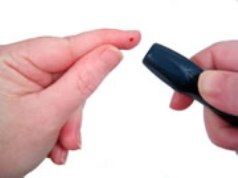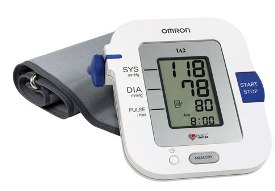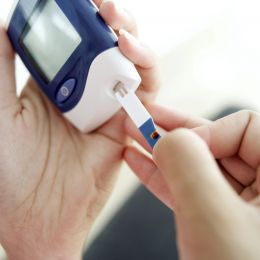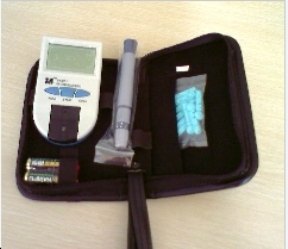|
What is Diabetes?
With the change in our diets, the increasing tendency towards people being overweight, the poor nutritional value of many of the foods that we can buy, and the poor choices of which food which we do eat we know that our health is being affected. When these nutrition factors are coupled with a lack of regular exercise then we are at risk of developing Adult Onset (Type 11) Diabetes. This is now becoming a major health problem, some people think it an epidemic, in modern society. In children this is seems to be a result of family history and genetics but for around 90% of cases the main cause is lifestyle choices and with change of diet and exercise it can often be avoided and in many cases existing cases can improve by applying better lifestyle choices to our lives. What is Diabetes?
Diabetes is a disorder of the metabolism where the body loses the ability to absorb sugar and starch from the blood. This disease now ranks among the top 10 causes of death in most developed and industrialized societies. The disease is characterized by the body’s impaired ability or failure to process glucose (a form of sugar) in the bloodstream because of the lack / absence of insulin. Insulin is a hormone produced in the pancreas that processes blood sugar into a form that the cells in the body can use for energy. Without the proper processing of sugar, the body either becomes hyperglycemic (too much sugar) or hypoglycemic (too little sugar). Both are dangerous as it can make the body react in any number of ways such as weakened kidneys, impaired nervous system, loss of sight and in some extreme cases, coma. Recent estimates project that nearly 180 million people are afflicted. Over a Fifteen years period the number of cases world wide has more than terbled. We are now looking at a potential 300 million people diagnosed. This is why some health experts and officials have deemed this problem as a global epidemic. It has become so widespread that the United States spends as $100 billion a year for the healthcare of diabetic Americans.
The disease comes in two forms: Type I and Type II. Both, however, are similar in that both types involve the hormone insulin in the body and its ability to process sugar in the bloodstream. Too much or too little sugar in the body has adverse effects leading to a huge range of medical complications. Diabetes is a devastating disease which can damage the vital organs of the body including the kidneys, heart, loss of eyesight and can lead to amputations (often toes and feet). It does not normally directly kill people but the complications from the problem from things like kidney and heart problems can lead directly to the sufferers death. People with this problem can survive the diseases provided they practice proper health care. Those who do not have the disease, but are in danger of getting the disease due to heredity, can avoid getting the Big D through proper nutrition.
What are Signs & Symptoms of Diabetes? The common symptoms are frequent urination, fatigue and being thirsty all the time. Diabetes simply means too much glucose in your bloodstream. Too much glucose in the body requires more water, thus making you feel thirsty most of the time. With thirst comes an increased water intake, making urination frequent.
However, not all people who actually have diabetes show these symptoms. Diabetes can already be quietly creeping inside your system without you knowing it, especially on its early stages. According to the current statistics of the American Diabetes Association, there are over 20 million people, in the US alone, who have diabetes.
Among these, around three quarters were diagnosed to have the disease, while the rest of those who have this problem do not know that they already have one. Also, in a study published in the New England Journal of Medicine couple of years back, 4 out of 112 obese adolescents have the silent type of diabetes.
Someone who is addicted to sugar or sweets is not necessarily a diabetic. Diabetes is a serious illness brought about by a person’s genetic disposition: his likelihood to develop a pancreatic disease. If your family is prone to the disease, read this article to detect the symptoms of a diabetic problem as early as possible. Type I Diabetes Symptoms
Type I is known as insulin-dependent diabetes mellitus (IDDM). This is the most severe and usually develops within a few days or weeks. In IDDM, the lack of insulin stems from destruction of the beta cells. The symptoms associated with IDDM are so distinct that they rarely leave any doubt of the diagnosis. They are as follows: • Polyuria: Urinating frequently and in large amounts is a classic symptom of the problem, as the body rushes fluids through the kidney to dilute the high levels of sugar in the urine. • Polydipsia: An unusual thirst is a natural result of too frequent urination: the body is signaling for lost fluids to be replaced. Dehydration will eventually occur if the condition is not caught early. • Polyphagia: This feeling of extreme hunger stems from the body's belief that it is starving because glucose is not reaching its cells to provide desperately needed energy. • Rapid Weight Loss: Most Type I patients are at or below their ideal weight. When IDDM begins, they may suddenly lose more weight—as much as 15 pounds in a week—even though they may be eating more than enough and have a good appetite. The lack of insulin means that calories, in the form of glucose, are being sent out through the urine and the body is beginning to burn fat reserves. • Weakness: Since muscle cells are not receiving their usual fuel, energy flags. Of course, fatigue can have many causes, which is why the problem can go unrecognized for so long. Be concerned if a once active child seems tired, drowsy, or listless for no apparent reason. Some children may also complain of stomach, leg, or chest pains, or have difficulty breathing. • Irritability: In youngsters, crankiness, confusion or excessive crying may warn of impending illness. A child may seem to be inattentive or may not be doing as well in school as before. • Nausea and/or Vomiting: These symptoms may precede ketoacidosis, as poisonous ketone acids build up in the blood when the body must resort to burning fat deposits for energy. • Blurred Vision: Excess glucose may be seeping into the eye, changing the shape of the lens. Difficulty in focusing or changes in eyesight from one day to the next—such as from nearsighted to normal vision—are other visual cues for possible a diabetic problem. TYPE II Diabetes Symptoms Type II, or non-insulin-dependent diabetes mellitus (NIDDM), makes up the majority of diabetes cases, estimated that about 13 million people in the US. Unlike Type I, Type II progresses more slowly. It can creep along unnoticed for years. Symptoms may appear gradually, becoming more intense or frequent with age. See your doctor as soon as you observe any of the following: • Any of Type I symptoms • Tingling or Numbness in Legs, Feet, or Fingers: Or you may have a burning sensation or heightened sensitivity in these extremities or on other spots on your skin. Symptoms, such as leg cramps, may appear or worsen only at night. Again, these may be signs that circulation is poor or that nerve damage is already progressing. • Frequent Infections: Diabetes weakens the body's defenses against invasions of bacteria. Infections of the gums, urinary tract, or skin that keep recurring or take a long time to clear up show that the disease may have begun interfering with the immune system. • Itching of Skin or Genitals: This may be the result of an underlying infection or dehydration, a common by-product of a diabetic problem. • Slow Healing of Cuts and Bruises: Because the problem affects how cells use the nutrients obtained from food, the body may have difficulty repairing damaged tissue. Diabetes also thickens blood vessels, slowing circulation and preventing wounds from receiving, through the blood, these needed nutrients and oxygen. • Hyperglycemia, or escalated blood sugar levels is a characteristic that is linked with the problem. This manifests itself through the symptoms of severe ongoing thirst, and constant need to urinate. It is important to note that hyperglycemia is not always just linked with a diabetic problem. It is a separate illness in itself.
Unfortunately, too many of these symptoms can be overlooked or blamed on other conditions. Make sure to have your blood sugar level checked yearly, at the very least, and more frequently if there are manifestations of any of the symptoms above.
Types of Diabetes
There are three different types of diabetes – Type I, Type II, and Gestational diabetes. ABOUT TYPE 1 DIABETES: Formerly known as the juvenile diabetes, Diabetes mellitus type 1 is usually diagnosed at a younger age, mostly during childhood. This type can be linked to the person’s genes. In this type, the pancreas has stopped producing insulin. Thus, in order for a Type 1 diabetic to survive, he needs to continuously take insulin shots.
Type I is known as insulin-dependent diabetes mellitus (IDDM). It is less common in the US though is the most severe and usually develops within a few days or weeks. In IDDM, the lack of insulin stems from destruction of the beta cells. The first type of diabetes (Type I) is contracted genetically. Most of the patients of this type are boys and girls of around 15 years old. It is because of this trend that experts have interchanged the term Type I diabetes with Juvenile Onset Diabetes. The disease works by fooling the body’s immune system into thinking that the cells responsible for producing insulin are harmful. The islets of Langerhans (as these cells are called) are attacked by the immune system, rendering the islets unable to produce the necessary hormone to process blood sugar. Diabetics of this type need to have insulin administered regularly into their system. As of now, the most common method for delivering the hormone is through injections. Other delivery systems are also being developed, the most recent of which is an oral spray that eliminates the need for hypodermic needles. This measure simply manages the condition but does not fully address the problem of curing it. Short of a pancreas transplant, there is no cure for Type I diabetes. And even then, the risks are considerable making anyone think twice before undergoing the procedure. This is because transplanted organs run the risk of being rejected by the recipient’s body even if blood types match. However, should the transplant prove successful, the diabetic may no longer have the need to have insulin artificially introduced into his / her body. A trade off exists in that in order to prevent organ rejection, the patient will have to take immuno-suppressive drugs throughout their lifetime, which may make him / her more susceptible to infections than usual. Even then, most patients who have undergone the procedure say that it is a price they are willing to pay in exchange for a life free of needles and in fear of the complications the disease brings.
ABOUT TYPE 2 DIABETES: Type 2 diabetes, also known as the adult-onset diabetes, is most common among diabetic patients – almost 90% of diabetic patients have this type. From the term adult-onset, this type of diabetes is mostly diagnosed at a later age in life. Some may have had it since childhood but just didn’t realize until later. This is because, most of the time, type 2 diabetes starts to show symptoms when it is already in the advanced stage. Type 2 diabetes can also be linked to the person’s lifestyle and diet. That is why people who are overweight or those aged 40 and above have greater risks in developing this type of the disease. Thus, to control or prevent having the problem in the future, we should all be mindful of the things we do and the food we eat.
Type II diabetes (also known as “adult onset diabetes”) or non-insulin-dependent diabetes mellitus (NIDDM) is characterized by the body’s failure to process sugar in the bloodstream despite the fact that insulin is produced by the pancreas. This could be because not enough insulin is produced or that the body simply does not respond to it. This form of diabetes accounts for 90 percent of the estimated 300 million cases of the disease worldwide. Unlike Type I, Type II progresses more slowly. It can creep along unnoticed for years. Symptoms may appear gradually, becoming more intense or frequent with age. See your doctor as soon as you observe any of the signs and symptoms that may indicate this condition. There is a huge correlation between Type II diabetes and obesity. Most obese individuals lead a sedentary lifestyle, while consuming food high in carbohydrates, sugars and fat. These poor eating habits coupled with the lack / absence of physical activity increases the volume of sugar in the bloodstream. The pancreas cannot produce enough insulin to meet the demands of processing so much sugar and therefore a diabetic problem sets in. At the end of this article is information on diet strategies for meal replacement programs. When using such programs as a diabetic there are very specific procedures that need to be followed to ensure that the condition is kept stable. Until recently, Type II diabetes was also called Adult Onset Diabetes, with the average age of a symptomatic patient around 40 years of age. But the increasing number of cases of children acquiring this type of the disease has led experts into setting this term aside. Type II diabetes is characterized by the body’s impaired ability / failure to process sugar despite the presence of insulin-producing cells. The pancreas cannot keep up with the demand to produce enough insulin to process sugar in the body. The cause for Type II diabetes is a lot less ominous than the first one. Whereas Type I is genetic, where the patient has no control over it, the second type of diabetes is usually brought about by a lifestyle of poor eating and exercise habits. Doctors and research scientists alike are finding more and more the direct proportion of obesity to Type II diabetes. Findings show that overweight and obese individuals are very likely to contract the disease and their chances of succumbing to the complications brought by the disease increase significantly. This is perhaps what makes Type II diabetes such an alarming situation. Many experts feel that the huge number of people living with this disease need not be as great had they observed proper diet and exercise. To manage the disease, Type II diabetics are instructed to exercise regularly, limit their carbohydrate and sugar intake and when absolutely necessary, have insulin administered artificially.
ABOUT GESTATIONAL DIABETES: The third kind is the Gestational diabetes mellitus : This occurs in about 2%–5% of all pregnancies and is a temporary and fully treatable disease. Gestational diabetes mellitus requires careful medical supervision during the pregnancy and if left untreated can develop into type 2 diabetes. This is only present in pregnant women, most of the time during the third trimester. This kind is usually caused by certain hormones brought about by pregnancy or, like the other types, lack of insulin. Ob-Gyns oftentimes require their patients to undergo the Oral Glucose Tolerance Test, especially when the woman is almost overweight due to her pregnancy. Even if this type ceases after giving birth, there is a big possibility that the woman will acquire Type 2 diabetes in the future. If no proper care is administered or left improperly managed, this stealth disease can lead to further complications. These complications may be heart, kidney or eye problems, impotence or even nerve damage. Therefore, careful management is really necessary for diabetic patients.
What Causes Diabetes?
While scientists aren’t exactly sure why Type 1 diabetes
happens, they do know the immune system is involved. A healthy
immune system protects us from diseases caused by infections,
such as colds or the flu, as well as diseases that start in our
own cells, such as cancer. For some reason, in certain people,
the immune system becomes confused and begins attacking and
destroying the cells in the pancreas that make insulin.4
In Type 1 psychological and emotional stress among mothers may trickle down to their kids and increase their children’s risk of having the problem. Mothers who experienced a stressful event such as divorce, domestic violence, mental tension and work pressure have an increased risk of developing a diabetic problem. Parents who are often stressed out or are having problems is the number one stressor among children. Without the parent’s knowledge, children may get stressed, raising level of cortisol-also called the “stress hormone”.
Cortisol is found adjacent to the kidneys and is released in response to either physical or psychological stress. It breaks down muscle protein into its component amino acid which then circulates the bloodstream. These amino acids are used by the liver in the manufacture of glucose for energy increasing blood sugar level and at the same time lowering the use of glucose as fuel. The excess and deficiency of cortisol in the body may trigger some system disorders such as autoimmunity damaging the insulin-producing beta cells thus resulting in insulin deficiency. Scientists aren’t exactly sure why Type 2 diabetes happens
either; however, they have identified that it occurs most often
in certain individuals. About 80 percent of people with type 2
diabetes are overweight, have high blood pressure, and have
high cholesterol levels in their blood Nutritional supplementation and weight control options are discussed under alternative health options at the end of this article.
Diabetes is a disease that stems from the lack of insulin. Insulin is a hormone produced by the body to process glucose. Glucose is a form of sugar that the cells of the body need for energy. But before a cell can use glucose, insulin is needed to process the sugar into a form the cell can absorb. Without insulin, the cells do not have the energy needed to run the body properly, making a person weak. Furthermore, since the glucose is not used up it stays in the blood, which is harmful to the body, particularly to the kidneys. Without proper treatment, the complications arising from the problem are many and severe. Some of these include eyesight loss (retinopathy), nerve damage, kidney failure, and in very severe cases, diabetic ketoacidosis (diabetic coma). Type II diabetes is primarily caused by the body’s inability to process glucose even if insulin is present in the body. This is mainly because there is too much sugar in the body and not enough insulin is produced to process the excess sugar. As such, the blood sugar levels rise while putting extreme stress on the pancreas. In the case of Type II diabetes, the pancreas is forced to produce so much insulin to cope with the high levels of sugar in the body. Unfortunately, if high sugar levels are maintained for long periods of time, the undue stress may cause the pancreas to break down.
Aside from heredity, the top cause of diabetes is improper diet. Modern man's propensity for leading hectic lives has led them into eating the wrong kinds of food. Man has become so obsessed with wealth creation and pleasure, that he has no more time to prepare a well-balanced meal. Thus, the modern man's diet consists of canned goods, processed fish, meat and vegetables that can be eaten immediately by just popping it inside a microwave. The modern world has convinced man to have a preference for refined food, from sugar to grains. Most people who are healthy all their lives are getting diabetes and the culprit is the kind of food they eat, and our ignorance as to the nutrient content of the food we eat. A diet high in carbohydrates has always been linked to an increased risk of a diabetic problem. This is because people who have the problem or who are at risk of getting the disease do not have the ability to process carbohydrates particularly sugars properly. Individuals suffering from diabetes and those who believe they are at a moderate or high risk of getting the disease must carefully follow a diet plan that is low in carbohydrates. The level of carbohydrates can definitely have a large impact in ones blood sugar levels. The difference between a healthy individual and someone suffering from a diabetic problem is that the body of the former has the ability to properly take note of the amount of sugar circulated within it. Insulin is immediately secreted by the body of a normal healthy person when blood sugar suddenly increases. The role of insulin is to send a message to the fat cells in the body to absorb the triglycerides and glucose in the blood. When glucose and triglycerides is absorbed by the fat cells, the blood sugar level returns to safe and normal levels. Diabetics have a problem with producing sufficient amounts of insulin. Some diabetics cannot produce any insulin at all.
Obesity makes one at a greater risk of getting a diabetic problem so it is also important to watch your weight. Those who have excess fat in the belly are more prone to being health risks. Weight gain or about 10 to 20 pounds, no matter how moderate, can also make one a candidate for diabetes.
Risk Factors:
The first type of diabetes (Type I) is contracted genetically. Most of the patients of this type are boys and girls of around 15 years old. It is because of this trend that experts have interchanged the term Type I diabetes with Juvenile Onset Diabetes. Diabetes is now considered by the American Heart Association a major risk factor in cardiovascular diseases. Other factors that contribute to the possibility of acquiring cardiovascular diseases in diabetic patients include hypertension, smoking, and dyslipidemia. - Hypertension. Hypertension in diabetes is considered a major contributor to the increase in mortality from cardiovascular diseases. Diabetic patients, especially those with Type 2, need to always have their blood pressure checked every visit to the doctor. Self-monitoring at home is also a must to maintain and control the rise of blood pressure. The American Diabetes Association recommends a target blood pressure of not more than 130/85 mm Hg to maintain a good level of blood pressure. - Hyperglycemia. Intensive glycemic control may prove to reduce the risk of cardiovascular events, although not directly. This can be more beneficial in controlling micro vascular complications, but still, assessing all risk factors and properly managing them is a big step in preventing occurrence of any cardiovascular diseases.
Obesity Obesity is a major risk factor for type II, adult onset, diabetes Poor Diet Poor eating habits and not consuming the full range of foods that you body needs every day is directly linked to type II, adult onset, diabetes. If left unchecked, the complications arising from diabetes are many and adverse. What are the health complications brought on by Diabetes?
- Retinopathy is the degeneration of the retina of the eye, leading to loss of sight. Diabetes is the number one cause of
blindness in people ages 25-74. Each year more than
15,000 people with the disease develop blindness. - Kidney diseases / failure sets in when the organ finally breaks down due to the excessive stress from filtering too much sugar in the blood. - Nerve damage: It is estimated that 65% of people with
diabetes suffer from mild to severe nerve system damage.
Symptoms such as impaired sensation in the limbs, carpal tunnel syndrome, and even impotence have been recorded among diabetics. - Amputations: When sensation is impaired in the limbs, infection from injuries may progress without being noticed, leading to no other resort but amputation. The number one cause of lower limb
amputations that is not related to a traumatic injury - Diabetic coma (diabetic ketoacidosis) occurs when a patient becomes severely dehydrated and metabolism is greatly imbalanced. Since the cells in the body are starved of energy, the entire body shuts down leading to a coma. - Heart Disease: People with a diabetic problem are 2 to 4 times
more likely to experience heart disease. - Stroke: If you have diabetes, you are 5 times more
likely to suffer from a stroke. These complications, however, pale in comparison to the number of lives that are lost every year due to diabetes. As of now, the number of deaths related to the disease is placed at around 4 million annually. But perhaps the greater tragedy is the fact that the adverse effect of the problem (particularly with Type II) could have been prevented. But seen from a different point of view, that is also part of the good news. By observing a healthy lifestyle of eating and exercising right, the chances of leading a full and productive life despite the disease are very possible.
Prevention:
The first way to prevent a diabetic problem, and probably the most important, is early diagnosis. The earlier this disease is diagnosed in your system, the sooner you can take action in managing it and, in turn, prevent further complications. The Canadian Diabetes Association actually recommend citizens over 40 years old to do regular screening every three years, and those with other high risk factors to do it every year. The simplest step one can start with is to stop smoking. Diabetic or not, cessation of smoking will really prove beneficial to one’s overall health condition. Maintaining blood pressure to less than 130/85 or 130/80 mm Hg helps control the occurrence of hypertension. Having a body mass index (BMI) of less than 27 is also a must for diabetic patients to control their overall condition. Some tests are also recommended to monitor and keep maintain key factors at a healthy level. These tests include annual urine test, retinal dilation examination, dental examinations, and biannual foot examination for sensation testing and measurement of pulses. Influenza and pnuemococcal immunizations also help in proper maintenance. Diabetes and cardiovascular diseases need proper attention and care. Regular visits to your health practitioner are recommended as they are the right people who know all about your condition. They keep all the records of their patients’ health history and can track improvements or otherwise. Proper medications and advice are also given by these professionals. Diabetes is indeed a life-long condition that demands a lot of attention. There may be no hard and real cure for this disease, but it sure can be maintained and controlled by proper care and having thorough knowledge and understanding about the condition. You must be familiar with the concept of Glycemic Index. The ability of different foods to raise blood sugar varies and is measured through the glycemic index. Starchy, high carbohydrates foods raise the blood sugar and have a high glycemic index. The idea behind low carb diets is to keep blood sugar low so your body won’t secrete significant quantities of insulin which in turn wouldn’t put blood sugars and triglycerides into your fat cells. And one of the ways to achieve this is to eat carb serving second during mealtime. This will ensure that by the time that the serving of carbohydrates come you will already be half full. Therefore you wouldn’t eat as much as you would have if the carbohydrate serving was served first. Having a healthy lifestyle with regular exercise combined with a healthy diet is also one way of preventing, or managing, diabetes especially Type 2. Any disease, in fact, can be prevented if one focuses on staying and living healthy. It's just a matter of changing our choice of food, like preferring whole grains over refined grains such as brown rice, whole wheat bread and the likes. Eat more fruits and vegetables and less meat, sweet and oily food. It also helps to read the labels of processed food, to determine the amount of one's carbohydrate intakes. Eating More Vegetables and Whole Grains
Will Help Prevent Diabetes
Medical findings have discovered that eating whole grain products might help prevent the problem. This is due to the effect that after eating grounded grain, for example: flour, pastas, pastries, etc., the body experiences an escalation in blood sugar. While on the other hand, eating whole grain products does not make the body sugar rise as much. Medical experts have found a healthy diet rich in whole grains will help prevent type 2 diabetes. All about carbohydrates Carbohydrates are categorized into two sections. Sugars and Starches. Most carbohydrates that is introduced into the body is turned into glucose. What happens is that the glucose goes into the body's blood stream. This in turn causes the body to release insulin. What insulin does is it causes glucose to go from the bloodstream into the cells, where it will then become stored energy source. The important thing is to achieve a proper balance between the intake of carbohydrates, right amount of exercise and insulin level that goes into the system. This is to make sure that the blood sugar level in the body remains regulated. Whole grains are good for you Instead of using bleached or white flours, individuals who have a diabetic problem should turn to whole grains instead. Whole grain products are by far healthier. They help maintain a good blood sugar level, since they do not make the level of blood sugar in the bloodstream rise so much. Maintain a balanced diet This means a lot of fruits and vegetables, and not burgers and fries! Fried foods are high in calories and fat! A healthy diet includes: food rich in fiber, whole grains, legumes, nuts, fruits and vegetables. Consumption of poultry products should be regulated. The use of salt should also be measured. Also they should drink plenty of water. The way you eat affects how your body functions To help maintain a healthy blood sugar level individuals should regulate their meals. This means as much as possible, try to eat meals at the same time each day. It would also be best if they try to consume the same amount of food for every meal After eating, a person's blood glucose escalates. If a person eats a huge meal one day and eats a light meal the next, his or her blood sugar level will become unstable. Also it would not be beneficial for those who have a diabetic problem to skip meals. Carbohydrates when absorbed turns into glucose. Individuals must keep track of the amount of carbohydrates that they consume. They can do this by reading food labels. Carbohydrates are usually measured in grams. It has been discovered that eating 5 to 6 small meals a day, is healthier than eating loads of food at one sitting. For the best possible method of regulating one's diet. Individuals who have a diabetic problem should consult a nutritionist. They will be able to provide a proper meal plan, that would be specifically designed to meet the needs of each and every individual!
Nutritionist It is important to consult a nutritionist because every person that has the problem requires a custom made dietary plan. One that is suited to promote good health. There are those individuals who have dietary needs that require special attention. Those who need to lose some pounds will benefit greatly from the assistance of a nutritionist. A nutritionist would be able to come up with a plan that would help individuals lose weight, while maintaining a healthy and balanced diet. Food Journal It would not be a bad idea for people who have a diabetic problem to list down all the foods that they eat per day. This is to keep track of all the food products they are consuming. So they would be aware of the types of nutrients that are going into their system. This will help them to maintain a healthy balance and balanced diet. Also, keeping a record would help individuals plan what types of meals they should be preparing in the coming days. People who have the problem will benefit tremendously from physical exertion. Exercising burns fat! It is an important addition to a healthy lifestyle. Walking is a great form of exercise, and does not require any type of machinery to be executed. A simple walk around the block, or a long walk from the parking lot to the grocery store will do the trick! Making some changes in a person's diet and lifestyle will come a long way in the prevention of diabetes. These are just simple steps that can be done, but the benefits are immeasurable.
Diet change: one of the best way to fight diabetes Many people today world wide do not get adequate amounts of vitamins and minerals in their diet.
Many don't even meet the minimum RDA (Required Daily Allowance) as set by government health
agencies. Likely you're one of those many. Your body needs vitamins and minerals to fight viruses,
disease, bacteria and pathogens that invade you on a daily basis. If fresh fruits and vegetables were
easy to acquire you wouldn't need the power of supplements. Diabetics lose a great amount of nutrients that are flushed away in the urine. The kidneys are stressed
as they try to rid your body of excess glucose. Unfortunately, a lot of vitamins and minerals get flushed
down the toilet along with the glucose. Your doctor likely hasn't told you about the importance of supplementation simply because he
either doesn't know and has never learned about the importance of supplements or, if he does, he finds
no profit in telling you. After all drugs are what he prescribes and what puts money into his pockets.
He knows next to nothing about prevention, nor does he know anything about natural alternatives to
any health problems. Unfortunately, this lack of education can lead you down the road to diabetic complications. and
an early date with the coroner. Without essential nutrients, your body simply breaks down. It ages
rapidly. Free radicals ravage the cells in your body, produce glycation and make room for diseased
cells to proliferate. Nutritional supplementation is discussed under “Vitamin and Nutrient Associations” at the end of this page. The key is to combine exercise with proper diet. Proper diet here not only refers to reducing calorie intake. It also means eating the right kind of food. One should avoid foods that are rich in fat particularly animal fat. They should also lessen their intake of red meat, dairy products and eggs. Processed and refined carbohydrates are big no-nos. These include refined sugar, white rice and white flour. Instead, one should consume whole grains like millet rice and unrefined rice (brown or red) and whole wheat. There are foods that have an insulin-like effect in the body when consumed. Some examples of these are: cucumbers, garlic, soy, wheat germ, avocados, green beans, buckwheat, flaxseed oil, green vegetables (raw) and Brussels sprout. People who believe that they are at risk of getting diabetes must increase their consumption of these foods. Intake of fiber can also greatly reduce the risk of diabetes. High fiber foods are usually low in sugar. Individuals with the problem or at risk of getting diabetes cannot process sugar properly. Individuals who are at risk of getting diabetes are advised to increase their fiber intake by taking fiber supplements such as guar gum, psyllium, oat bran or glucomannan.
They should also consume more vegetables, fruits, whole wheat products and whole grain products. Intake of white sugar and foods high with it must be cut. You must replace these foods with ones that have high fiber content. People should also stay away from alcoholic drinks if they really want to avoid having a diabetic problem. Alcohol decreases glucose tolerance especially in the elderly and those already at high risk of getting the problem. Moreover, diabetics who consume even moderate quantities of alcoholic drinks have a great risk of damaging their eyes and nerves. Apart from alcoholic drinks, smoking must also be avoided to be safe from getting diabetes. Cigarettes increases the risk for heart disease, kidney problems and other health concerns connected to the problem. Heavy smokers are more likely to become diabetics than non-smokers. So if you are currently it is of your best interest to quit the habit. If you don’t smoke then just don’t pick up the habit. Exercise protects you from diabetes Both type 1 and 2 diabetes can be avoided and improved with a regular moderate exercise regimen. In fact, individuals with type 1 diabetes who exercise regularly require less insulin while healthy individuals who exercise regularly are less likely to develop type 2 diabetes. This is because working out reduces the amount of body fat and thus improves the sensitivity of the body to insulin. The exercises need not be strenuous. Simple aerobic activities like walking, running, swimming and cycling can greatly improve blood sugar levels. Exercise improves the utilization of glucose by the muscles involved. This effect can last up to more than two days. Blood fat profile and blood pressure which also affects the problem also improves with regular exercise. Individuals, especially those who are already diabetic, must monitor their blood sugar level when exercising. This is because exercise can either increase or decrease blood sugar. It is always advisable to ask your physician before going into an exercise program.
When to seek Medical Advice:
Do you feel thirsty all the time? Do you frequently urinate? Do you have sores or wounds in your body that do not heal easily? Do you get tired easily? If you answered yes to most of these questions, then you might consider checking up with your doctor. A person who exhibits any of the symptoms of the disease or who belong to the high-risk group like having family members who have diabetes, should have himself examined by a doctor as soon as possible The Canadian Diabetes Association actually recommend citizens over 40 years old to do regular screening every three years, and those with other high risk factors to do it every year. Among the tests to assess a person's risks of getting diabetes are the glucose test, urine test, fasting plasma glucose test which measures the level of glucose in a person's blood after fasting for 12 to 14 hours, the oral glucose tolerance test which is also performed after fasting for three hours and the random plasma glucose test which can be done at any time. The number of persons getting the disease has been increasing in the past years, due to poor eating habits, increasing inactivity and other factors that could have been prevented. Having yourself checked for diabetes can help you understand the disease. But no matter what you do to manage your diabetes, it would have been better if you were able to prevent it from affecting you.
Treatment/Therapy:
Diabetes, actually, is much better to manage now than years before. It is because people are now well educated about this condition. There have been several studies and researches done as well to continuously learn more about diabetes and find more ways in managing and controlling it. Being conscious about the condition, proper management, continuous medication, and a healthy lifestyle are the keys to really prevent this condition from further aggravating and decrease the possibility of much more complications. Having the problem requires careful examination of ones sugar level. Besides watching for sign of high blood sugar, they also have to be aware of warning signs of blood sugar or hypoglycemia. Using blood glucose meter, a person who has diabetes can tell his/her sugar level is low. Normal fasting blood sugar is 70 to 100 mg/dl. Most Type I diabetic patients manage the disease by having insulin artificially administered. The most common methods are pills and hypodermic needle syringes. Other delivery methods are being developed as well, such as an oral spray that delivers the patient’s required amount of insulin. Anti-diabetic medicines that are taken orally by the mouth are effective as insulin injection in controlling symptoms of the problem. The number of people with diabetes continues to rise while their ages at the time of diagnosis drop. Type 2 diabetes, which used to be called adult - onset diabetes, is now striking children, due largely to the obesity epidemic. Overweight and obese kids that present identifying symptoms like darkness around neck and armpits area are those who frequently get urinary tract infection (UTI). The disease works by fooling the body’s immune system into thinking that the cells responsible for producing insulin are harmful. The islets of Langerhans (as these cells are called) are attacked by the immune system, rendering the islets unable to produce the necessary hormone to process blood sugar.
Short of a pancreas transplant, there is no cure for Type I diabetes. And even then, the risks are considerable making anyone think twice before undergoing the procedure. This is because transplanted organs run the risk of being rejected by the recipient’s body even if blood types match. However, should the transplant prove successful, the diabetic may no longer have the need to have insulin artificially introduced into his / her body. A trade off exists in that in order to prevent organ rejection, the patient will have to take immuno-suppressive drugs throughout their lifetime, which may make him / her more susceptible to infections than usual. Even then, most patients who have undergone the procedure say that it is a price they are willing to pay in exchange for a life free of needles and in fear of the complications the disease brings. For Type I diabetes, no real cure exists, except for a pancreatic transplant. Since the patient’s own pancreas has been compromised by the diseases, new pancreas is needed to restore the body’s own ability to produce insulin. There already have been reported and successful cases of pancreatic transplants, but the risks and stakes are very high. The chances are great that the body’s immune system may reject the new part leading to very serious and fatal complications. Furthermore, research shows that a good number of those successful pancreatic transplants involved having undergone a kidney transplant as well. The mortality rate of patients who’ve undergone just the transplant of the pancreas is greater compared to cases of patients who’d undergone pancreas and kidney transplants. Those with Type II diabetes may not need artificial insulin administration. A different medication can be coupled with a controlled diet and exercise. As there is a proven correlation between Type II diabetes and obesity, doctors and health experts recommend obese individuals to undergo a regimented weight loss and management program to combat the disease. However, in advanced cases of Type II diabetes, artificial insulin administration could be prescribed. The cause for Type II diabetes is a lot less ominous than the first one. Whereas Type I is genetic, where the patient has no control over it, the second type of diabetes is usually brought about by a lifestyle of poor eating and exercise habits. Doctors and research scientists alike are finding more and more the direct proportion of obesity to Type II diabetes. Findings show that overweight and obese individuals are very likely to contract the disease and their chances of succumbing to the complications brought by the disease increase significantly. This is perhaps what makes Type II diabetes such an alarming situation. Many experts feel that the number of people (over 160 million) living with this disease need not be as great had they observed proper diet and exercise. To manage the disease, Type II diabetics are instructed to exercise regularly, limit their carbohydrate and sugar intake and when absolutely necessary, have insulin administered artificially.
Omega 3 & 6 fatty acids A lot of evidence exists to show that Omega 3 and Omega 6 fatty acids can have a significant impact on stabilizing diabetic problems. Using such supplements does not replace insulin but there is strong evidence to suggest that these supplements can assist in stabilizing brittle diabetics and to slow the rate of increase on the number of units of insulin that a diabeties sufferer is using every day. The University of Maryland Medical Center says: “Individuals with diabetes tend to have high triglyceride and low HDL levels. Omega-3 fatty acids from fish oil can help lower triglycerides and apoproteins (markers of diabetes), and raise HDL, so people with diabetes may benefit from eating foods or taking supplements that contain DHA and EPA. ALA (from flaxseed, for example) may not have the same benefit as DHA and EPA because some people with diabetes lack the ability to efficiently convert ALA to a form of omega-3 fatty acids that the body can use readily. There have been slight increases reported in fasting blood sugar levels in patients with type 2 diabetes while taking fish oil supplements.” They further say in relation to weight control: “Many individuals who are overweight suffer from poor blood sugar control, diabetes, and high cholesterol. Clinical studies suggest that overweight people who follow a weight loss program that includes exercise tend to achieve better control over their blood sugar and cholesterol levels when fish rich in omega-3 fatty acids (such as salmon, mackerel, and herring) is a staple in their low-fat diet.” Link UMMC )mega 3 study Diabetic Foot Care
Diabetes is a disease that can lead to very serious complications such as blindness and amputation of limbs due to gangrene. For that reason -- if you have the problem, be sure to take care of yourself.
Here are some Diabetics health tips for you to remember as you try to properly care for yourself: 1. Stay on schedule with your medication. 2. Exercise regularly. 3. Take special care of your feet. 4. Most importantly, keep checking your blood glucose levels. 5. Drink a lot of water every day -- at least 64 ounces. 6. Eat a healthy diet. 7. Ward off gum disease as much as possible by brushing and flossing your teeth properly and often. 8. Get plenty of sleep. If you find yourself leading a lifestyle with little physical activity while consuming food high in sugar, you should take stock of your current lifestyle and seriously consider changing. Consult with a doctor to help you assess your current state as far as diabetes is concerned. The sooner these are done, the better. As you become kinder to your body, it will respond accordingly. Support System Those who are newly diagnosed with the problem can enter hospital programs where they are educated about the disease. They are also informed about new dietary plans, and changes they need to incorporate into their lifestyle to lead a healthy life. People who have just discovered that they have diabetes need a strong support system. During this time they might feel extremely vulnerable. They would need emotional support. This is the time where family and friends come in handy. Especially during the time they are still adjusting and discovering ways to come to terms with their new health condition. There are also many diabetes support groups that have
walking clubs that meet daily. You can join a club and meet
other diabetes sufferers who will help keep you on the right
track and motivate diabetics to exercise more. They can provide inspiration and encouragement by
sharing success stories and by keeping you aware of the
complications that can arise if the disease is left untreated. Once you get into fairly good shape, you might try playing a
sport that you enjoy, like golf or tennis. You could also join
a gym and participate in some yoga or aerobics classes to add
some variety to your workout plan.
Diet change strategies: Diet Therapy for Type I Diabetes: (1) The timing of your meals must be regular. A sample
meal schedule should look something like this: Breakfast
7:00 am, Snack 10:00 am, Lunch 12:00 p.m., Snack 3:00 p.m.,
Supper 6:00 p.m., Snack 8:00 p.m. The key is to not go too
long without eating something.
Prolonged periods without supplying your body with some
food can be dangerous resulting in hypoglycemia.
Hypoglycemia is a fancy term for low blood sugar. People
end up in the hospital because they let their blood glucose
level get too LOW - Yes, too low. Symptoms of hypoglycemia
include sweating, rapid heart rate, tremors, nervousness,
hunger, faintness, and weakness. Your blood sugar can get so low (40 mg/dl or below) as to
cause damage to nerve tissue. If you are experiencing a
headache, double vision, confusion, or irregular motor
skills, you need to take action. What do you do? Eat!
You need to get something in your body that will increase
your blood glucose level. People with type I diabetes
should always carry a source of food that will help bring
the blood glucose level up fast. I would recommend candy,
juice, glucose tablets - anything sugary. (2) Eat about the same amount of food at the same time each
day. It is very important for you to know correct portion
sizes and be able to incorporate them into your meal
planning. Learn how to incorporate the Exchange Lists into
your diet. Learning the exchange system makes it easy for you to
manage your food distribution throughout the day. This
results in keeping your blood glucose level at a safe,
healthy level. (3) Monitor your blood glucose levels throughout the day
adjusting your insulin doses for the amount of food eaten.
Insulin doses should also take into account your level of
activity. Consult your doctor for adjusting insulin
doses. You should be familiar with he sliding scale. Diet Therapy for Type II Diabetes: (1) Diet therapy does not have to be as strict with type II
diabetes. If you have type II diabetes, your emphasis
should be to achieve and maintain recommended blood glucose
levels (70-140 mg/dl), cholesterol levels (200 mg/dl or
less), and blood pressure (120/80 is normal). (2) Weight loss is often beneficial for people with type II
diabetes. Mild to moderate weight loss is known to help
control this type of diabetes significantly, even if the
desirable body weight is not achieved. Losing 20 to 30
pounds of excess weight results in significant improvement
in respect to the goals listed above in number (1). Weight
loss can help so much that your medications to help control
your blood glucose level will probably need to be decreased. If you would like to search for more information on
the problem, here is a link to the Centers for Disease Control
and Prevention´s Diabetes Homepage: CDCP The following link will take you to a site with Diabetic
Recipes: Diabetic Gourmet Calorie Recommendations:
(While this has been written for people with
diabetes, the information contained in it can help anyone
achieve a healthier diet.)
(1) Gender: (2) Weight: (3) Height: (4) Age: (5) Activity Level: (6) Pregnant or Breastfeeding: To determine your calorie needs, you may want to consult
with a dietitian or another health professional who is an
expert on the problem. You can do so by either
Newly Diagnosed? Why you need a Nutritionist
One of the most important things that people who have just been diagnosed with the problem have to pay attention to is their dietary plan. They have to make sure that they have a proper diet. This will help them maintain good health, and well being! It is a must for people who have diabetes to acquire the assistance of a nutritionist. This is because every individual that has diabetes requires a dietary plan that is customized to suit their needs. A good nutritionist will be able to assess the type of meal that an individual needs depending on what type of health concerns he/she might have. Those people who need to shed some pounds will benefit greatly from nutritionists. A nutritionist will be able to help them come up with a dietary plan that will help them lose weight, while maintaining the nutrients that their body needs. Carbohydrates The important thing is to achieve a proper balance between the carbohydrates, having enough exercise and the right amount of insulin. This is to make sure that the blood sugar level in the body remains regulated. Regulate your meals After eating, a person's blood glucose escalates. If a person eats a huge meal one day and eats a light meal the next, his or her blood sugar level will become unstable. Carbohydrates when absorbed turns into glucose. Individuals must keep track of the amount of carbohydrates that they consume. They can do this by reading food labels. Carbohydrates are usually measured in grams. Also, it would be best if individuals try to consume the same amount of food for every meal. Another thing that is important is not to skip meals. For the best possible method of regulating one's diet, those who have diabetes should consult their doctors. They will be able to provide a proper meal plan that would be specifically designed to meet the needs of each and every individual. Eat protein serving first to prevent diabetes Much has been said about the link between a high carb diet and diabetes but very little is documented about the connection between protein and diabetes. In fact, the role of protein in the diet of people at risk or suffering from the problem has been marred in controversy. According old studies, most of the protein consumed was converted to glucose in the liver and raises blood glucose level as it entered the bloodstream. Like carbohydrate, protein is also converted into glucose by a process called gluconeogenesis. And also similarly, the speed of this process depends on the amount of insulin secreted by the pancreas and the blood glucose control. According to the same old studies, diabetic individuals convert protein to glucose very rapidly which can lead to a very negative effect on blood glucose level. In healthy, normal individuals, the intake of protein can stimulate insulin release as much as carbohydrates can. This has led experts to believe that eating protein does not help avoid hypoglycemia. However, new studies have shown that while and estimated 50% to 60% of protein consumed is converted to glucose, it does not enter the bloodstream and thus does not raise the rate of glucose discharge by the liver. Nobody has yet to discover where the glucose goes. One theory speculates that it is probably stored in the liver or muscles as glycogen. But experts agree that it is least likely to affect blood glucose levels. Now it is recommended hat people at with or at risk of acquiring diabetes includes more protein in their diets. The suggested amount of protein is 15 to 20 percent of the daily calorie intake. The protein however should be distributed throughout all the meals. In eating animal protein, one should make sure to choose only the lean parts and combine them with non-animal protein like those found in vegetables. The amount of protein intake must not increase 20 percent of calories though as this may lead to the development of kidney disease. People with kidney problems should reduce the amount of protein intake to slow down or halt the progression of the disease. One way to include more protein in your diet to prevent diabetes is to have protein servings first during mealtime then have carbohydrate rich foods served second. An advantage of having protein serving first during mealtime is that it can reduce the amount of carbohydrate intake of your body. The logic here is that you would already fill full after the serving of protein so you would have less inclination to consume carbohydrates. Individuals who have the problem or who are at risk of getting the disease do not have the ability to process carbohydrates particularly sugars properly. This is why a diet high in carbohydrates has always been linked to an increased risk of diabetes. Individuals suffering from the problem and those who believe they are at a moderate or high risk of getting the disease must carefully follow a diet regimen that is low in carbohydrates. This is to ensure that their sugar levels would not be affected by an increase intake of carbs. One simple fact that people should remember about carbohydrates is that they all break down into simple sugars. Whether you are eating complex carbohydrates like brown rice or whole wheat bread or you are consuming simple sugars like candies and white sugar, they would all end up as simple sugars inside your body. Complex and simple carbohydrates differ only in the rate at which they are converted to basic sugars. Carbohydrates are converted to simple sugars from five minutes to 3 hours after consumption. Complex carbohydrate breaks down slower than simple sugars. This means that the impact of simple sugars and complex carbohydrates in the blood sugar level of individuals differs. Individuals must therefore take note of their daily carbohydrate consumption in order to prevent diabetes. This is a very important thing to do if you really do not want to raise your blood sugar level. A good and effective way to achieve this is to eat protein serving first during mealtime.
Vitamin & Nutrient Associations
Vitamins, Minerals and Supplements against Diabetes Here are a few significant vitamins, minerals and supplements against diabetes. Vitamin D A research conducted in Finland, where people are exposed to very little sunlight, proved that Vitamin D protected children against high blood sugar, a first sign of diabetes. The experiment was conducted on 12,000 children who were administered Vitamin D from birth (1966). Researchers published in 2001 that they have observed that 80% of the risks for diabetes were reduced, mainly preventing high blood sugar, than that of those that did not receive Vitamin D supplements. Vitamin E Vitamin E is a fat-soluble nutrient found in milk, plant leaves and wheat germ oil. It has been proven to aid reproduction in both lab experiments and actual human experience. A widely used form of Vitamin E, alpha-tocopherol is ingested into the body in the form of gel capsules. Though its effect in diabetes prevention is real, an increase in the vitamin intake was not proven to be proportional to the level of prevention. Minerals Magnesium and potassium are minerals that aid in carbohydrate and protein metabolism. The proper breakdown and synthesis of carbohydrate into simple sugars is a function that diabetics lack. With the aid of the two minerals, it can help prevent the disease. Chromium and zinc facilitate the recognition of insulin in the body. Supplements Mamordica Charantia (bitter melon) is a vegetable that is rich in nutrients that enhance the production of beta cells, thus improving insulin production by the pancreas. In the Philippines, where the plant originates, it is a recommended supplement. Chinese herbal medicine also swears by this plant and actually uses it traditionally to address sterility, skin diseases and gastro-intestinal diseases. If one is able to tolerate the bitter taste, then it promises a high chance of improving pancreatic activity (by as much as 54%). Coupled with a sensible diet and healthy lifestyle, using vitamins, minerals and supplements like the ones above, can help fight the problem. Even when we try to eat well, we're disadvantaged. The nutritional content of most food has been compromised over the years, not only by deficient soils and modern production, transportation, storage and processing methods, but also by the enormous amounts of chemical and artificial substances added to promote growth, storage life, taste and appearance. It's for this reason that more and more medical authorities are advocating the use of vitamin and mineral supplements. However, finding them in the right combination can be both confusing and costly. Supplementation and Meal Replacement Programs and Diabetes Weight loss programs If you are overweight and have diabetes then losing weight is a major priority for you. There is a lot of information available through our AtoZ directory and here a quick link to the main weight loss page: Weight Loss Use of a weight loss program is an obvious way to work on the problem but if you are diabetic you will know that you need to be careful about how you approach any change in your diet and food habits. We will walk through some of the issues here so you are clear that you can be on a weight management program in a way that will support rather than hinder your diabetes problem.
We need to look at how nutrition supplements should be used and show you the pitfalls and the solutions offered by that style of supplement if they are combined with a meal replacement product. The same principles will apply to any weight loss/reduced calorie diet. Most meal repacement programs are base around a soy based amino-protein powder that is used as a meal replacement for weight loss and a meal supplement for weight gain. This is often supported by a range of herbal and vitamin & mineral tablets to give a balanced nutrition foundation for weight loss and for wellness. There are a few issues here that can cause problems for a diabetic and the use of meal replacements can be a terrible challenge for diabetics. If you use one as directed on the can you will have extended times without food and without sugars and then end that “fast” with a large food/sugar hit. You will be aware that this can be a big problem. We know that food, especially herbs, gets into your body quickly and gets out quickly so any supplement you are using should be taken 3 times a day. The meal replacement is to be used for 2 meals and a “normal” meal of whatever you would normally have for the third meal. Vitamin and mineral supplements are used at each normal meal time. For a diabetic this does not work so you need to make adjustments. Instead of taking a nutrition “shake” in the morning and one at lunch you need to halve the powders and take half for breakfast, half for morning tea and then another half serve for lunch and the other half of the second serve for afternoon tea. This gives you a steady flow of nutrition and the stabilizing influence of the soy products that are the foundation for the shakes on a regular pattern. The sweetness in the shakes is generally fructose (fruit sugars) that are helpful in keeping diabetes stable. Using such a program in this manner tends to stabilize sugar levels. “Brittle” diabetics are people who tend to have sudden drops in blood sugar that can be very pronounced and even cause blackouts. In these cases a week or so on this regular nutrition program normally balances out the problem and the energy drops are much less prominent for them. The other controlling factor is the medium the shakes are mixed in. If you use a fruit juice then you are taking extra fructose. If you use Soy Milk then you have a different level of sugar intake. It is good to play with these as a tool to help balance the diabetes problem. A word of warning. If you are looking at any meal replacement it is wise to use one with a soy base. If, as many are, the shake is milk based then anyone with lactose intolerances or other milk allergies with have problems. If you are using a meal replacement program like this then the nutrition supplements play a big role in improving overall wellness and improving the metabolism and that also works towards a feeling of more energy and better weight loss results.
Blood health. Earlier we talked about the use of Omega 3 & 6 fatty acids. We quoted The University of Maryland Medical Center saying: “Individuals with diabetes tend to have high triglyceride and low HDL levels. Omega-3 fatty acids from fish oil can help lower triglycerides and apoproteins (markers of diabetes), and raise HDL, so people with diabetes may benefit from eating foods or taking supplements that contain DHA and EPA. ALA (from flaxseed, for example) may not have the same benefit as DHA and EPA because some people with diabetes lack the ability to efficiently convert ALA to a form of omega-3 fatty acids that the body can use readily. There have been slight increases reported in fasting blood sugar levels in patients with type 2 diabetes while taking fish oil supplements.”
As Aloe Vera Juice is a refreshing and anti-bacterial drink, you might find that taking this daily, diluted in some filtered water will not only refresh you like ‘a shower inside you’ but also assists in dealing with any digestive issues you may also be experiencing. You may find benefit from our information on detoxification as well as a bit about detoxing because of change of diet We wish you well in your search for solutions to this problem and your movement towards better health in all areas. More Resources available about Diabetes : Diabetes in adolescents These problems are not only faced by adults, but also adolescents who get diabetes in their childhood. The important factor in treatment of the problem is to keep the blood sugar level normal at all times.
One of the best sources for information pertaining to
diabetes is the American Diabetes Association (ADA). Here
is a link to their Web site: ADA On the side bar of ADA´s Web site, look for "Diabetes
Information". Under that sub-heading, click on "Take the
Risk Test" for a quick online test to see if your are at
risk. Under the same sub-heading, you will find "General
Information", information for "Newly Diagnosed"
patients, "In the News" for the latest updates, "Tip of
the Day", and so much more. Be sure to check out
the "Recipe of the Day". If you are at risk, see your doctor to be tested.
development of Type II diabetes can be postponed. Through
proper diet and exercise habits, you may never develop
this disease. Use this article as your wake up call to
start eating healthy. Here is a link for Diabetic Recipes: Soar Berkeley
Guidelines for a diabetic diet rely on the proportion of
carbohydrates to proteins and fats. The diet needs to
provide some dietary fat to help prevent post-meal spikes
in blood sugar levels. However, saturated fats should be
limited to reduce the risk of heart disease. Protein
should be kept to 20% or less of your daily calories in
order to prevent or delay the onset of diabetic kidney
disease.
We also feature new health articles & self care solutions every month in “Your Health Success” our FREE Health Magazine, so subscribe today to stay up-to-date!
 to “Your Health Success” our monthly F’R’E’E’ Newsletter
If you are interested in products mentioned on this site and want to check pricing and availability in your country, then please click back to the home page of the person who referred you here.
Back to Top of your health online Diabetes page *** GENERAL RELEASE AND ASSIGNMENT I understand that in submitting my material for publication I am granting the rights to reproduce this material on the internet or in other form and I have read the conditions above
============================================================
|

















